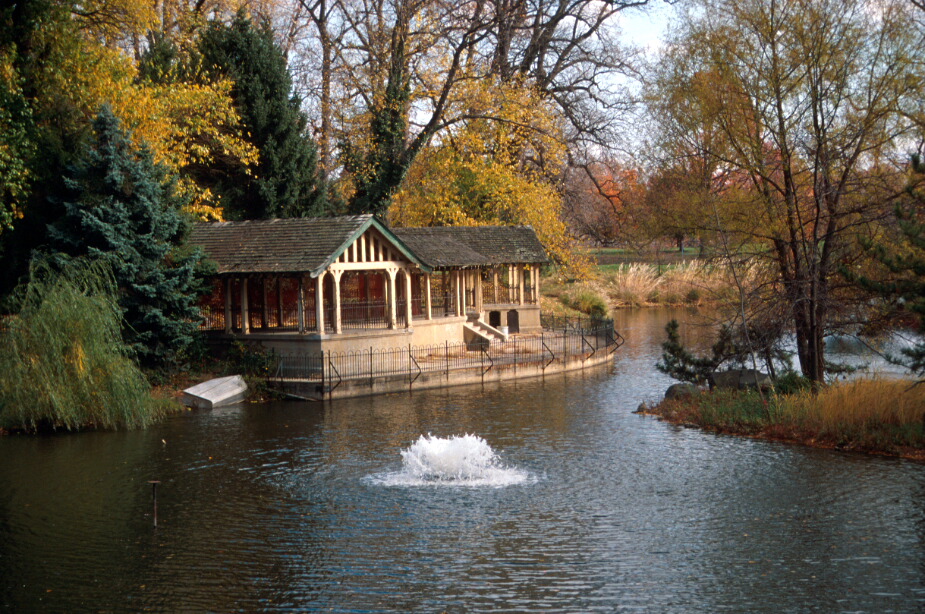
Photo credit:
Elizabeth Jo Lampl, 10/1996
|
Druid Hill Park Historic District
Inventory No.:
B-56
Date Listed:
5/22/1973
Location:
2700 Madison Avenue, Baltimore, Baltimore City
Category:
District
Period/Date of Construction:
1860-1890
Architect/Builder:
Architect (structures): George A. Frederick
Boundary Description:
Bounded by Jones Falls Expressway, Druid Lake Drive, Auchentoroly Terrace, Reisterstown Road, and Druid Park Drive
|
|
Description:
Druid Hill Park is America's third public park and a jewel of landscape architecture. The district covers 746 acres in West Baltimore. The original estate featured an imposing Neo-Classical house built between the 1790s and 1800s for Colonel Nicholas Rogers. In converting the estate to a park, the City capitalized on this prominently sited mansion by turning it into a public pavilion, primarily by encircling it with a wide, columned piazza. George A. Frederick designed a series of structures for the park including an Etruscan triple arch entranceway, a group of 13 picnic shelters, an octagonal stable, and a conservatory. Structures built for the park included a superintendent's house, exotic trolley stations, contemplative fountains, impressive greenhouses, monumental entrances, and more. Today, the park's built environment indicates the Romantic and exotic architectural tastes of the mid and late 19th century. Resources in the Italianate and Stick Styles remain, along with those of Moorish, Asian, and Islamic influence. The park also features turn-of-the-20th-century and 20th-century buildings in the Classical Revival, Mission, and Modern styles. The park is also graced with a number of decorated spring heads which served fresh water to patrons and, in designated areas, to horses. Three reservoirs were built within park grounds all prior to 1873, the largest of which still remains as Druid Lake, completed in 1871. It was created by constructing the first major earth dam in the United States.
|
Significance:
In 1858 Baltimore Mayor Thomas Swann instituted a policy of setting aside 20% of the revenue from mass transit fares to finance the purchase of city parks. This special fund was used to purchase the Druid Hill estate, consisting of 746 acres which had been laid out in the manner of an English garden for its owner, Colonel Nicholas Rogers. Druid Hill Park, the third public park in the country, is significant for its architecture, landscape architecture, engineering, and social history during the period c. 1750 to 1956. The park's fine collection of built resources, including buildings, structures, and objects, exemplifies the Victorian penchant for architectural eclecticism. Structures of exotic Asian and Chinese influence share the park with those of the more indigenous Gothic Revival and Classical Revival idioms. The park is also significant as a strong example of a designed landscape of high artistic value. Druid Hill Park features outstanding examples of the Picturesque and Beautiful landscape aesthetics, as well as the characteristics of an active recreation center. The park's waterworks of reservoirs, rock-lined streams, and spring-fed fountains are evidence of the skill required to adapt a varied terrain to functional and decorative purposes. The 1864-1871 construction of Druid Lake dam, in particular, employed superior technical skill and is recognized today as a civil engineering landmark. There are also three cemetery sites within the proposed district. A reported slave cemetery at an undisclosed location on the South Lawn is able to yield information in the future. The Rogers Family Cemetery, established c. 1750, has significance due to age and is the reason that the park's period of significance stretches back prior to its 1860 incorporation as a municipal park. Druid Hill Park was also the site of events of exceptional significance associated with the Civil Rights Movement of the 20th century. Of all the parks in the city, Druid Hill Park was the one most frequented by the black community of Baltimore in the early 20th century, and therefore the park most associated with the African-American history of recreation in Baltimore. The park was the site of at least one now famous racial struggle over integration, and several less noticed but nonetheless significant attempts at racial justice. The period of significance for Druid Hill Park Historic District, therefore, is from c. 1750, the date of the Rogers Family Cemetery, to 1956, the date the park's recreational facilities were ultimately integrated.
|
|